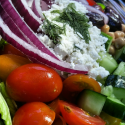How to Make Healthier Meals:
If you’re like me, you may be looking for a simple, stress-free approach to healthy eating, then you’re in the right place! Over the years I’ve studied, tested and verified this approach. My health wasn’t always in great condition; I had to work hard to figure it out. These are the ten best recommendations I’ve found to be most beneficial for good health. This guide will help you navigate food choices no matter where you are on your path to healthier living. You should see your health care provider for specific recommendations for starting a healthier diet. I’ve found on my own and by coaching others, eating the right foods can be a choice loaded with obstacles, cravings and emotional eating. Feel free to reach out to me about my health & wellness coaching program. I’d love to help!
Here are the 10 tips for healthier meals:
-
Go unrefined:
Choose whole wheat or whole grain for your pasta, bread, and rice. Your body will benefit from more fiber, vitamins and minerals. Fiber satisfies your appetite and makes you feel fuller longer than low fiber foods, many of which are highly processed. Eliminate white flour, white bread, and white rice from your diet entirely.
-
Eat more fruits and vegetables:
How much more? 3 servings of fruits and 5 servings of vegetables per day is a good starting point. The USDA recommends 4-13 servings per day, depending on the item. And you’ll need a variety of colors because these represent different health benefits your body needs. You might like this recipe for roasted rainbow sheet pan vegetables or Agave Lime fruit salad.
-
Reduce or eliminate meat:
Add healthy plant protein. This can reduce the amount of saturated fats in your diet which is good for your cardiovascular system. Eating too much meat is one of the quickest ways to build dangerous plaque in your arteries and make your cholesterol levels too high; which can cause heart attacks. One of the healthiest meats is turkey. Try this meat-less lentil chili recipe. It’s delicious! Lentils are legumes and one of the easiest to cook because they don’t require soaking in water overnight.
-
Replace saturated fats with unsaturated healthy fats:
But, still limit them, because all fats are loaded with calories. The additives, pesticides, and chemicals involved in processing artificially created and preservative laden oils have been linked to things like immune system issues, infertility, behavioral problems, and liver and kidney damage, and the big problems of our day: cancer and heart disease. However, our body needs fat for rebuilding cells and hormone production. And, it can only use what we give it.
The best fats for cooking:
These are coconut oil, or palm oil. Use low temperature cooking oils such as extra virgin olive oil or, at higher temperatures when combined in equal amounts with coconut oil. If you don’t want the coconut flavor, buy expeller-pressed coconut oil. Avocado oil is beneficial in uncooked foods. Also, when used sparingly, so are walnut oil, flaxseed oil and macadamia nut oil. Eating salads is very beneficial, but, to make them even healthier, try reduced oil or an oil-free salad dressing like these.
-
Keep portion sizes reasonable:
For example, 3 to 4 ounces of meat, poultry, or fish is about the size of a deck of cards. Studies have found that the typical portion size is 2 to 8 times as large. Most plant-based foods are far higher in protein than meats, fish or poultry, but without the accompanying saturated fats. You don’t need to eat meat to get sufficient dietary protein.
-
Use fewer sweeteners:
Soft drinks are a major source of sugar and calories for many Americans, especially children. Though juice is more nutritious than soft drinks, it’s also high in calories, so most people should drink no more than one cup a day. Not surprisingly, high sugar consumption is strongly associated with some of the world’s leading killers… including heart disease, diabetes, obesity and cancer. Drink fruit flavor infused waters instead like these recipes for spa water.
-
Use a salt substitute-Don’t add too much salt:
The USDA recommends less than 2,300 mg, about one teaspoon, daily. Spices and herbs are a good way to flavor foods naturally. The problem is, most processed foods are loaded with saturated fat, salt and sugar. Many are created using trans fatty acids and hydrolyzed fats. This brings us to our next recommendation.
-
Clean eating-Eliminate or reduce processed foods:
As mentioned above, they contain too much saturated fat, salt, and sugar, and not enough vitamins, minerals and live enzymes. The bigger picture is they also contain harmful chemicals, preservatives, artificial ingredients, and dyes. Foods that have been chemically processed and made solely from refined ingredients and artificial substances are what are generally known as processed food. Eating refined, processed foods over time can deplete the body of essential nutrients needed for proper function.
-
Reduce Junk foods with little or no nutritional value:
Our appetite gravitates towards foods that are sweet, salty and fatty, because we know such foods contain energy and nutrients that we need for survival. Many processed foods have been engineered to be so incredibly “rewarding” to the brain, that they overpower anything we might have come across in nature. But, the body’s pleasure center is still rewarded whether we’re eating foods found in nature or not. Foods engineered to be “hyper rewarding”, effectively short circuit our innate resistance to over-consumption!
-
Avoiding foods which cause you allergic reactions:
These 7 foods cause about 90% of food allergy reactions. They are: milk (mostly in children), eggs, peanuts, tree nuts (like walnuts, almonds, brazil nuts, and pecans), soy, fish and shellfish. Although any food can cause an allergic reaction, food allergy reactions typically occur when your immune system overreacts to a food or a substance in food. Your body is inappropriately triggering a protective response. Some food reactions are extremely life endangering and some are mild. If you suspect you have a food allergy, you can be tested at an allergist’s office for a range of food to identify your allergy triggers.
Thanks for your interest in eating healthier!
There are hundreds of easy, healthy and delicious recipes on this website. Have you read the post, “How and Why to Eat a Plant Based Diet”? You can read that now by clicking here. Or, check out the recipe gallery to see what looks good. If you’d like some support along the way in building healthier habits and sticking to your health related goals, you can find more information on health & wellness coaching here.





